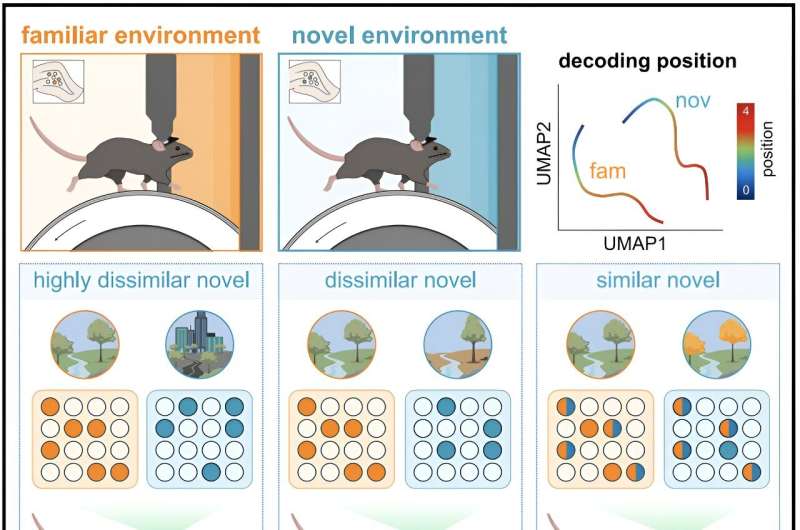July 11, 2024 feature
This article has been reviewed according to Science X's editorial process and policies. Editors have highlighted the following attributes while ensuring the content's credibility:
fact-checked
peer-reviewed publication
trusted source
proofread
Coordinated activity of mossy cells contributes to encoding of spatial and contextual memories, study finds

The hippocampus is a crucial region in the brain of mammals, which has been predominantly linked to the formation of memories. The retrieval of memories stored in the hippocampus at a later stage relies on a process known as "pattern separation," which entails the separate processing of and encoding of similar memories.
Past studies suggest that the dentate gyrus (DG), an integral part of the so-called hippocampal formation, contributes to pattern separation. However, the unique contributions of specific cell populations in the DG have only been partially uncovered.
Researchers at the University of Freiburg recently carried out a study specifically investigating the role of hilar mossy cells (MCs), a class of excitatory cells in the DG, in the encoding of spatial and contextual features of memories. Their findings, published in Cell Reports, suggest that these cells support pattern separation processes by coding context and space.
"The dentate gyrus plays a key role in the discrimination of memories by segregating and storing similar episodes," Li-Wen Huang, Federico Torelli, Hung-Ling Chen and Marlene Bartos wrote in their paper.
"Whether hilar mossy cells, which constitute a major excitatory principal cell type in the mammalian hippocampus, contribute to this decorrelation function has remained largely unclear. Using two-photon calcium imaging of head-fixed mice performing a spatial virtual reality task, we show that mossy cell populations robustly discriminate between familiar and novel environments."
The researchers performed a series of experiments on live mice. They observed the activity of MCs in the brain of mice using a technique called two-photon calcium imaging as the mice were exploring familiar and new environments via virtual reality (VR).
The mice were shown three different VR scenes, which varied in terms of familiarity with contextual cues. The researchers then used the MC activity recordings to train machine learning models. Interestingly, they found that algorithms trained on the activity of these cells were better at identifying highly dissimilar and dissimilar contexts than similar ones.
"The degree of discrimination depends on the extent of visual cue differences between contexts," Huang, Torelli, Chen and Bartos wrote in their paper. "A context decoder revealed that successful environmental classification is explained mainly by activity difference scores of mossy cells. By decoding mouse position, we reveal that in addition to place cells, the coordinated activity among active mossy cells markedly contributes to the encoding of space."
The findings gathered by the researchers suggest that the degree of remapping in the activity of MCs depended on the difference between visual cues observed in the environments navigated by the mice. This suggests that these cells contribute to pattern separation processes within the DG by decorrelating contextual information based on the extent of visual differences in the environment.
The recent work by this team of researchers sheds new light on the unique contributions of MCs, one of the primary excitatory cells in the DG, to the separate processing and encoding of similar memories. In the future, it could pave the way for new studies further exploring these contributions or focusing on the role of other DG cell populations.
More information: Li-Wen Huang et al, Context and space coding in mossy cell population activity, Cell Reports (2024). DOI: 10.1016/j.celrep.2024.114386
© 2024 Science X Network




















